What Animals Can Run Longer Than Humans
From shape-shifting to living forever, the animal kingdom seems to take unlocked the secrets to all the crazy abilities nosotros wish we had. In this list, nosotros volition explore the incredible and surprising talents of a range of animals—from the canis familiaris to the curious chameleon.
10 Come across Different Colors
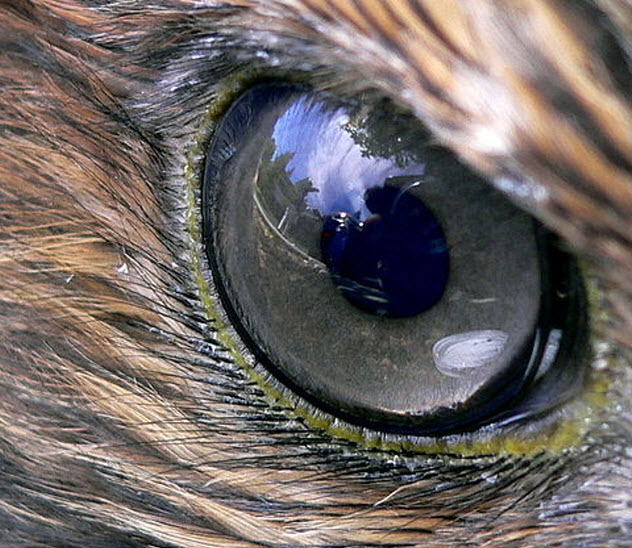
Endeavour to imagine a different color. It seems impossible, doesn't it? Fifty-fifty when we think we're thinking of a unique color, information technology is but a combination of colors we are able to perceive. In fact, at that place are a vast collection of other colors which we every bit humans are unable to cover.
Birds have the fascinating ability to come across colors which are invisible to humans. This is due to the extra color cones in their retina which are sensitive to the ultraviolet range. Interestingly, this discovery was actually made by accident in the early on 1970s by a researcher studying the ability of pigeons to discriminate colors.
With this knowledge, a lot more than beliefs virtually birds tin be reexamined, such as their option of a mate. To us, the female and male versions of each bird look pretty much the same, peradventure with a slight difference to distinguish between genders. (For example, a male robin is darker in color than a female person.)
Even so, to the birds with their UV vision, each bird could actually look quite different. This would suggest that birds are really more selective near their mates, suggesting that they accept a more conscious arroyo to mating than previously thought.
ix Run On Water
The ability to walk on h2o may seem to us to be something merely truthful in the Bible with Jesus himself. Still, within the animal kingdom, running on water isn't such a holy power. The mutual basilisk cadger (Basiliscus basiliscus), otherwise known as the "Jesus Christ cadger," has the unique ability to run beyond water.
How the basilisk manages to pull off this incredible stunt is really due to physics. Adult basilisks tend to weigh around 200 grams (seven oz). The cadger uses its hind legs to propel itself beyond the h2o, usually reaching a maximum distance of 5 meters (15 ft) before beginning to sink.
The verbal method used by the lizard was analyzed past a graduate pupil at Harvard University, who discovered that the stride used by the lizard can be divided into three sections. The lizard slaps his foot confronting the h2o past moving it vertically downwards, then strokes the water by moving his foot backward, and finally brings his pes back out of the water and returns to the starting position.
So sadly, this lizard is not a miracle working, simply he still has one up on humans.
8 Defy Gravity
Alpine Ibex on Dam – hybridwildlife.com
We all know that birds have the ability to fly, which is an obvious trait that we as humans lack. But what nearly a creature with no wings that is able to defy gravity, besides?
Encounter the Alpine ibex caprine animal. Just looking at him, you might non exist impressed simply wait until you hear what he can practise. Ibex goats have the incredible ability to sew hills that are virtually perfectly vertical. Not only that but they can hold their residuum on the tiniest of ledges.
They also have the power to spring 2 meters (half-dozen ft), which makes galloping upwards vertical terrain barely even a challenge. The ibex goat uses its gravity-defying powers to escape its predators, which include wolves, bears, foxes, and lynx. Fifty-fifty the nigh skilled predators struggle to match pace with the ibex as it glides with ease upwardly some of the steepest terrains in Europe. I'd like to encounter a human accept on this challenge.
7 Be Immortal
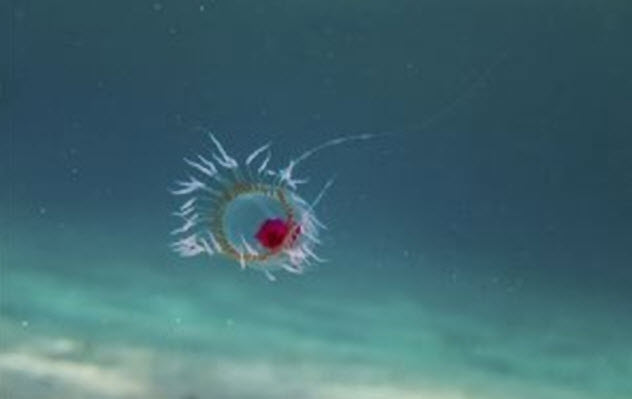
For decades now, scientists accept been putting work into finding the surreptitious to immortality. In fact, scientist Aubrey de Gray suggests that it could be possible in the next 25 years, although many other recognized scientists dispute this. Nonetheless, for the Turritopsis nutricula (a jellyfish), immortality is just a part of life—pun intended. So what is the hole-and-corner to its immortality?
When the Turritopsis nutricula (more normally known every bit the immortal jellyfish) reaches its developed form of 4.5 millimeters (0.2 in) and has reproduced, it reverts to its beginning stages of life. Instead of dying, the jellyfish transforms back to how it started life by shrinking its body, retracting its tentacles, and allowing itself to sink to the bottom of the sea floor.
One time this happens, the jellyfish is able to commencement its cycle of life all over again . . . without dying! This doesn't just occur once. The immortal jellyfish can continue to repeat this process for, well, forever. As far as scientists can tell, at that place is no limit to the number of times the jellyfish tin restart its life. So as long every bit this incredible animal tin avoid the mouths of sea predators and stay away from fatal diseases, information technology can live forever.
6 Regenerate
For us humans, when an organ fails or we lose a limb, nosotros expect in hope toward the astonishing field of medical science. It's indisputable that nosotros have come up very far in our advancements in creating prosthetic limbs and managing to make use of donated organs.
But what if we could magically regenerate the declining trunk part effortlessly without the need for science to intervene? Well, if we were all axolotls, we could. This exotic amphibian has the power to regenerate encoded into its immune system. Immune cells named macrophages help the axolotl in regenerating parts of its trunk.
In almost mammals, these cells are used in an injury response to digest pathogens and create healing signals. However, when James Godwin (a atomic number 82 regeneration written report author) observed the way these cells act in the axolotl, he was startled to detect that anti-inflammatory signals were already present. In other mammals, these signals would not be present until later when the fauna is recovering from the injury.
Godwin also realized that the maximum number of macrophage cells were present at the axolotl'south wound four to 6 days after the injury. Curious about this, Godwin removed the macrophages from some of the axolotls and this took away their ability to regenerate. This all shows that the macrophage cells behave differently in this amphibious beast, giving it the remarkable ability to regenerate.
5 Have 360-Degree Vision
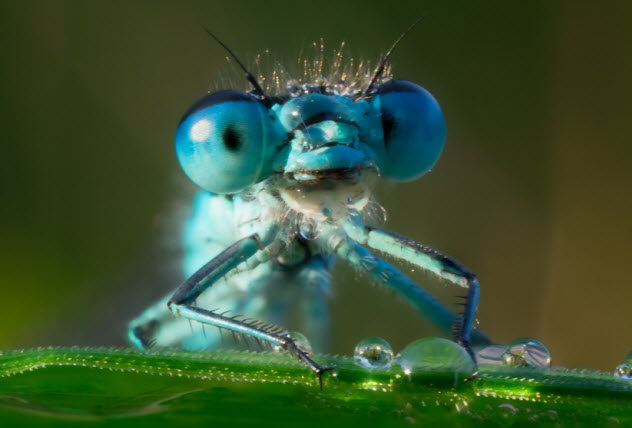
The homo visual field covers approximately 50–60 degrees horizontally and fifty–70 degrees vertically. To usa, this visual field feels pretty decent. Information technology's hard to imagine being able to see more than what we already tin.
However, for the chameleon, the human visual field is laughable. Chameleons are ane of two animals which are able to run across in full 360-degree vision. (The other is a dragonfly.)
The chameleon has unique eye anatomy, which enables it to rotate its optics with a high degree of freedom. Another fascinating aspect of the chameleon's eye anatomy is its incredible talent to switch between monocular and binocular vision. This allows information technology to view two split up objects with each eye independently or to focus both optics on one object (which is what we exercise).
The dragonfly uses its 360-degree vision mainly for the purposes of hunting. Of all insects, the dragonfly has the largest optics—hardly surprising since 80 percentage of its encephalon is defended to the control and process of sight.
4 Shape-Shift
About intelligent Mimic Octopus in the world
Shape-shifting might sound like something from a sci-fi film, just a made-up concept for entertainment purposes. But actually, at that place is 1 incredible animal with the bizarre ability to mimic the shape of other animals.
The mimic octopus is a curious variety of octopus which was showtime discovered in 1998 off the coast of Sulawesi in Republic of indonesia. Although the power to change the exterior colour of the peel is common to all varieties of octopus, this intelligent creature takes that one step farther. It tin can physically reform itself to appear similar a different animal.
Non only this but the mimic octopus too gets into graphic symbol by taking on the characteristics of the species information technology is impersonating. This is unique from other animals which try to appear like other animals as a defense technique, such equally some varieties of flies which take on the yellowish-and-black stripes of bees to make potential predators cautious of them.
The mimic octopus'southward list of impersonations include sole, lionfish, jellyfish, and sea snakes. I'g pretty sure that shape-shifting into your part beats any interim parts I've seen in a human play. Information technology'south just a shame that they don't have Oscars nether the sea.
three Sleep With Half Of Their Brain
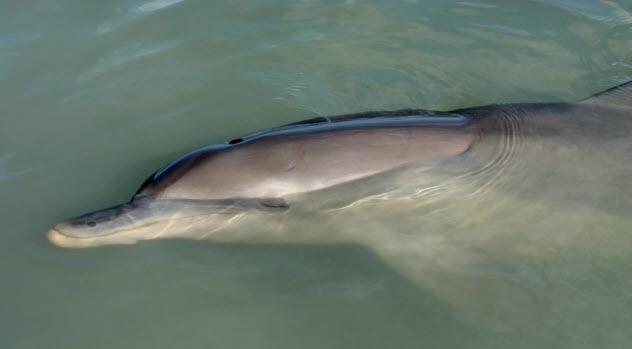
Wouldn't it be convenient to never accept to slumber? Well, if you were cetacean, you could. Cetaceans are a grouping of marine mammals—consisting of dolphins, whales, orcas, and porpoises—that have the unique power to sleep with one hemisphere of their encephalon at a time.
This kind of sleep is called "unihemispheric boring-moving ridge sleep." Information technology allows the encephalon to recover from daily happenings and fuse new memories. While the left hemisphere sleeps, the cetacean closes the right middle and uses the right hemisphere to control animate functions and go on the creature aware of its environs. When the right hemisphere sleeps, the opposite happens.
However, while one hemisphere is sleeping, the cetacean cannot function in the way it usually does. Dolphins in captivity have been observed either floating inertly at the top of the pool or lying at the bottom. (They volition occasionally surface for air as the active hemisphere keeps their breathing functions going.) This method of sleeping allows cetaceans to rest each side of their brain for approximately 4 hours in a 24-60 minutes period.
2 Reach 188 Decibels
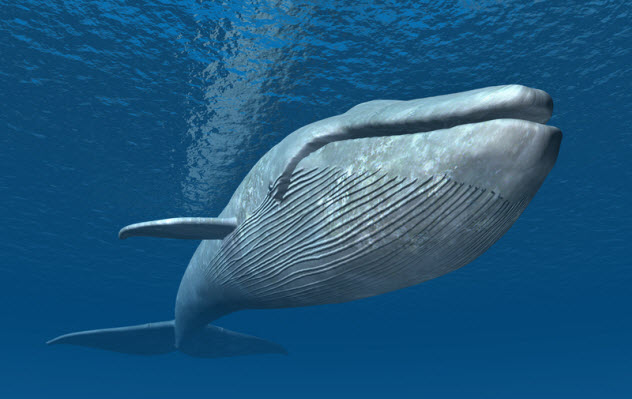
If y'all were to shout at the top of your voice, the highest decibel range you could maybe accomplish would exist around 90. The loudest shout e'er produced past a human was achieved by an Irish teacher who ironically screamed the word "quiet." She managed to reach 121.7 decibels.
An incredible achievement . . . for a human, simply information technology has aught on the blue whale. As the largest animate being known to man, it's hardly surprising that the bluish whale is able to produce the loudest sound. Merely what might surprise you is the amplitude of that sound.
The low-frequency vocalisation of the blue whale can achieve an incredible 188 decibels. That is much louder than a jet, which peaks at 140 decibels. Just think how loud they sound when they fly overhead, approximately xi kilometers (7 mi) above yous.
In fact, that blueish whale's sound is so loud that information technology is fashion above our threshold of pain, which peaks at 130 decibels. The audio is and then loud that it tin be heard from 800 kilometers (500 mi) away, which is the equivalent of existence heard in San Diego from San Francisco. It's idea that bluish whales utilize their loud projection to attract mates from across the sea.
1 Predict The Future

Although sometimes we may feel like we can sense when something bad is going to happen, this is mainly due to our memory functions and associations with past events. However, for some animals, the ability to sense danger earlier it happens is office of their instinctive nature.
A grouping of researchers looking at the migration of golden-winged warblers concluded that the birds were capable of predicting when a storm was going to hit days earlier it happened. The researchers tracked the birds during their migration from Southward Africa to the United States. However, there was an odd trend in the information. Equally the birds were approaching the southern United States, they took an precipitous, unexpected detour—merely like they knew something was wrong.
As it turns out, there was a humongous tempest that striking the region but a few days later. Information technology was then traumatic that information technology saw the death of 35 people. But storms aren't the only affair that the fauna kingdom can warn us about. On a more personal level, animals tin can alert us to health issues much earlier than we would recognize the symptoms ourselves.
With their incredible sense of scent, dogs can actually be trained to sniff out cancer. In 2011, dogs used in a Japanese study were able to sniff out colorectal cancer from breath samples with a 98 percent accuracy rate. This is truly a phenomenal ability and could save the lives of hundreds of cancer victims by detecting the illness early and allowing time for treatment.
Jaydon is a 17-year-former student from England who is interested in writing and discovery. You tin can follow him on Twitter hither.
Source: https://listverse.com/2016/06/21/10-incredible-things-animals-can-do-that-we-cant/
Posted by: tolivertione1970.blogspot.com

0 Response to "What Animals Can Run Longer Than Humans"
Post a Comment